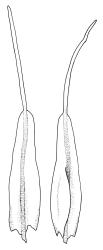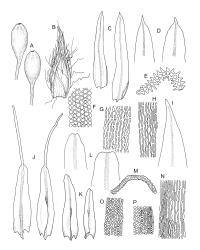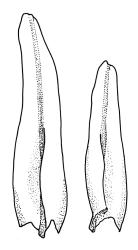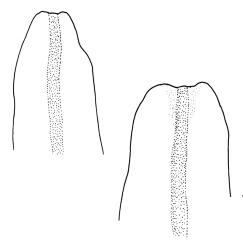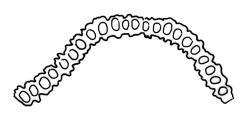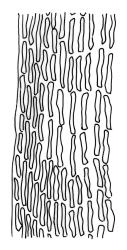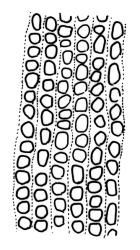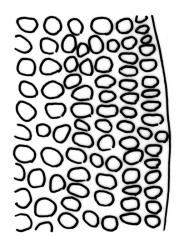- ≡ Macromitrium appendiculatum Müll.Hal., Hedwigia 37: 156 (1898) nom. illeg., non Macromitrium appendiculatum (Renauld & Cardot) Paris 1897
Plants slender to moderately robust, ± dull, olive-green to yellow-brown above, dark green or brown below. Branches wiry and often long, to 25 mm, erect, mostly simple, penicillate at apices. Stem leaves erect-flexuose when dry, recurved-squarrose when moist, lanceolate-acuminate. Branch leaves spiralled around the branch and with apices twisted to one side or recurved when dry, spreading from a ± erect base and neatly funiculate when moist, broadly ligulate to oblong-lanceolate at maturity, usually ± broader below, retuse or obtuse and often asymmetric at apex, strongly keeled, (1.2–)1.5–2.5 mm; immature leaves with a linear, stiffly flexuose, and deciduous arista c. 1.0–2.0 mm long; margins entire, plane or weakly recurved on one side; upper laminal cells irregularly rounded-quadrate, thick-walled, in longitudinal rows, bulging, obscured by low, multiple papillae, unistratose, mostly 5–9 µm diam. (lumina c. 5–6 µm across); mid laminal cells thick-walled and mostly ± rectangular, usually sparsely papillose, mostly 7–14 × 7–8 µm; inner basal cells long-rectangular to elongate, irregularly thick-walled, with lumina straight or nearly so, smooth or with low, conical papillae, mostly 20–40 µm long, (lumina (2–)4–6 µm wide); marginal basal cells scarcely differentiated. Costa excurrent to form an arista (present only in immature leaves), the abaxial superficial cells elongate in mature leaves (covered by laminal cells on arista), in cross-section with c. 4–5 guide cells in 1–2 layers, 1–2 layers of abaxial stereids, and few or no adaxial stereids. Gemmae absent.
Dioicous. Perichaetial leaves similar to branch leaves, but more gradually narrowed to a persistent arista. Male plants and sporophytes not seen.
Macromitrium retusum has similar fragile and penicillate aristae, but is readily differentiated by smooth upper leaf cells, and ligulate to oblong leaves spiralled around the branch.
NI: N Auckland (recorded from one locality by Vitt 1983), S Auckland, Gisborne, Hawke's Bay, Taranaki, Wellington; SI: Nelson (near Upper Tākaka, St Arnaud, Lake Rotoroa, Punakaikī and vicinity, near Greymouth), Marlborough (Pelorus Bridge Scenic Reserve), Canterbury (Port Hills), Westland (Kellys Creek, Lake Kaniere), Otago (eastern parts only), Southland; St (fide Vitt 1983); Ch.
Endemic.
Epiphytic on tree trunks and larger branches in lowland podocarp-broadleaf forest, particularly in shrubby forests at road and track margins. This species is especially common on Carpodetus serratus and Leptospermum scoparium, while other host species may include Aristotelia serrata, Coprosma pseudocuneata, Fuscospora solandri s.l., Lophomyrtus bullata, Melicytus ramiflorus, M. chathamicus, Parsonsia sp., Pseudopanax sp., Sophora sp., and Dacrydium cupressinum. Also occurring on the introduced Cupressus macrocarpa and rarely on rock. Associated epiphytic bryophytes include Calyptopogon mnioides, Cladomnion ericoides, Glyphothecium sciuroides, Leptostomum inclinans, Lepyrodon australis, Macrocoma tenue, Macromitrium gracile, M. longipes, M. prorepens, Neckera hymenodonta, Tetraphidopsis pusilla, and Porella elegantula. On the North I. occurring from near sea level (near Wanganui, Wellington L.D.) to at least 760 m (Lake Waikaremoana, Gisborne L.D.), and on the South I. from near sea level (Punakaikī, Nelson L.D.) to at least 600 m (St Arnaud, Nelson L.D.).
Vitt (1983) observed that M. helmsii is more frequent on the North I. than on the South I. He stated it to be "not uncommon from the Hamilton-Rotorua area south to Wellington" and this is corroborated by collections made since his revision. W. Martin (in herb.) stated that it is the "commonest species on trees" at Mt Bruce (Wellington L.D.).
On the South I. it is more scattered in distribution and appears to be most frequent in the Nelson L.D., where it has a considerable elevational range, and in eastern Otago. There are no records from Fiordland (Southland L.D.) and the few records from Canterbury L.D. (see Vitt 1983, fig. 122) require clarification.
Only female plants are known for M. helmsii. The obscurely papillose upper laminal cells and leaves abruptly narrowed to mostly fragile, penicillate aristae characterise the species. The first of these features, together with sparsely papillose and elongate basal laminal cells, a characteristic leaf set, and wiry branches, clearly ally M. helmsii with the M. gracile complex. Confusion occurs with fragile-leaved forms of the related M. gracile; distinctions between M. helmsii and M. gracile are detailed under the latter species. Vitt & Ramsay’s (1985) "M. gracile group" includes M. helmsii, M. gracile, M. incurvifolium, and two other Australian species.



